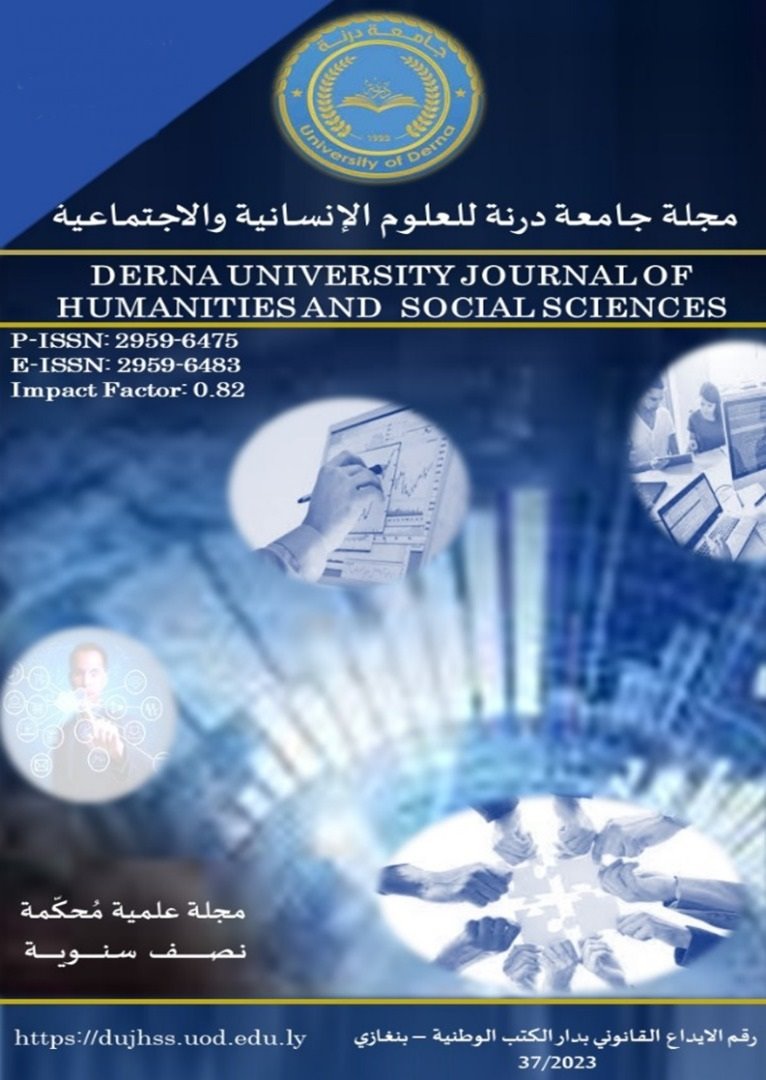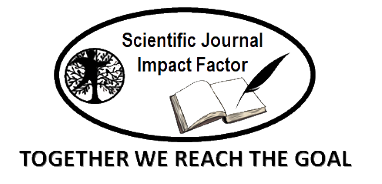Syntactic Errors in Verb Phrases Made by English Major Students in Written Composition at Omar Al-Mukhtar University
Keywords:
Syntactic Errors in Verb, Phrases Made, English Major Students, Written Composition, Omar Al-Mukhtar UniversityAbstract
This study aimed to analyze the syntactic errors made in verb phrases by 35 students in written composition. The participants were English major students at the third and fourth years at Omar Al-Mukhtar University. Each participant wrote an essay and the written samples were collected for the analysis. The study classified the errors made by the participants using James’s (2013) Surface Structure Taxonomy. The analysis of the data revealed that the participants produced a total of 545 verb phrases, of which 461 (84.59%) were correct and 84 (15.41%) were incorrect. Of the 84 incorrect verb phrases, 41 (48.84%) were classified as misformation, 25 (29.76%) were due to addition, and 18 (21.43%) were due to omission. The learners made 44 interlingual errors and 40 intralingual errors. The number and type of errors varied significantly across participants. The analysis attributed these errors interference from the participants' first language, and individual differences in language proficiency and learning strategies. This study provides insights into the challenges faced by language learners in producing verb phrases in second language writing and emphasizes the need for tailored instruction and support to develop language proficiency.
References
Abied, A., Ali, A., & Ashfello, M. (2022). Error analysis of the written English essays by Libyan EFL learners: Case study of Alasmarya University EFL students. Journal of Humanitarian and Applied Sciences, 7(13), 425-442.
Al Harbi, A. A. M. (2017). Evaluation Study for Secondary Stage EFL Textbook: EFL Teachers' Perspectives. English Language Teaching, 10(3), 26-39.
Al Jawad, A. S. H., & Mansour, A. A. (2021). An exploration of grammatical errors in written English of Libyan EFL students with special reference to Arabic as their first-language. Journal of World Englishes and Educational Practices, 3(7), 07-25.
Al-Jabri, S. (2011). A Study on Verb Phrase Errors Among Jordanian EFL Learners. Journal of Language Studies, 15(3), 102-118.
Al-Jarf, R. S. (2002). Training ESP College Students in Electronic Searching. Online Submission.
Algeo, J., & Butcher, C. (2014). The origins and development of the English language. 7th Edition. Wadsworth Cengage Learning.
Alsied, S. M., Ibrahim, N. W., & Pathan, M. M. (2018). The use of grammar learning strategies by Libyan EFL learners at Sebha University. ASIAN TEFL, 3(1), 37-51.
Altoate, A. M. (2022). Spelling, noun phrase and verb phrase errors in the writing of Libyan learners of English: a corpus-based analysis (Doctoral dissertation, University of Birmingham).
Aslani, M., & Tabrizi, H. H. (2015). Teaching grammar to Iranian EFL learners through blended learning using multimedia softwares. Journal of Applied Linguistics and Language Research, 2(8), 76-87.
Celce-Murcia, M., Larsen-Freeman, D., & Williams, H. A. (1983). The grammar book: An ESL/EFL teacher's course (p. 854). Rowley, MA: Newbury House.
Corder, S. P. (1975). Error analysis, interlanguage and second language acquisition. Language teaching, 8(4), 201-218.
Corder, S.P. (1967). The Significance of Learners' Errors, IRAL 5(4), 161–70.
Ellis, R. (1997). Second language acquisition. The United States: Oxford, 98.
Fareed, M., Ashraf, A., & Bilal, M. (2016). ESL learners’ writing skills: Problems, factors and suggestions. Journal of education and social sciences, 4(2), 81-92.
Hourani, T. M. Y. (2008). An Analysis of the Common Grammatical Errors in the English Writing made by 3rd Secondary Male Students in the Eastern Coast of the UAE (Master's thesis, The British University in Dubai).
Hubers, F., Trompenaars, T., Collin, S., De Schepper, K., & De Hoop, H. (2020). Hypercorrection as a by-product of education. Applied Linguistics, 41(4), 552-574.
Huddleston, R. & Pullum, G. K. (2002) Cambridge Grammar of the English Language. Cambridge: Cambridge University Press.
James, C. (2013). Errors in language learning and use: Exploring error analysis. Routledge.
language. 7th Edition. Wadsworth Cengage Learning.
Levin, B. (1993) English Verb Classes and Alternations: A Preliminary Investigation. Chicago/IL: The University of Chicago Press.
Merriam, S. B., & Tisdell, E. J. (2015). Qualitative research: A guide to design and implementation. John Wiley & Sons.
Moses, R. N., & Mohamad, M. (2019). Challenges faced by students and teachers on writing skills in ESL Contexts: A literature review. Creative Education, 10(13), 3385.
Ngangbam, H. (2016). An analysis of syntactic errors committed by students of English language class in the written composition of Mutah University: A case study. European Journal of English Language, Linguistics and Literature, 3(1), 1-13.
Quirk, Randolf, Sidney Greenbaum, Geoffrey Leech & Jan Svartvik.1985. A Comprehensive Grammar of the English Language. London: Longman.
Richards, J. C. (1980). Second language acquisition: Error analysis. Annual Review of Applied Linguistics, 1, 91-107.
Selinker, L. (1972). Interlanguage. International Review of Applied Linguistics 10, 209-231
Wu, H. P., & Garza, E. V. (2014). Types and attributes of English writing errors in the EFL context-A study of error analysis. Journal of language teaching and research, 5(6), 1256.
Zawahreh, F. A. S. (2012). Applied error analysis of written production of English essays of tenth grade students in Ajloun Schools, Jordan. International journal of learning and development, 2(2), 280-299.



























